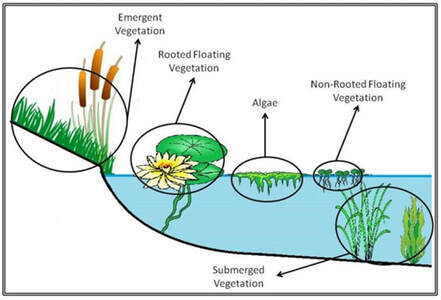Often overlooked and sometimes considered a nuisance, aquatic plants are beautiful and important parts of a healthy lake ecosystem.
Benefits of Aquatic Vegetation
|
Aquatic plants play important roles in lakes including:
|
Listen to Dr. Elizabeth Carroll describe the benefits of aquatic plants in lakes. For her complete seminar, see our PLEON page.
|
- Limiting Shore Erosion
- Aquatic plant roots help stabilize shorelines and limit the effect for erosion from waves by slowing down the waves before they hit the shore.
- Reducing Pollution
- Aquatic plants take up nutrients and other pollutants and traps sediments, improving water quality and clarity.
Forms of Aquatic Plants
|
Aquatic plants come in several basic forms:
1. Emergent: these plants are found along the shoreline with most of their biomass out of the water. Portions of their roots and stems may be submerged. 2. Submerged: these plants are entirely underwater most of the time. Flowers or seeds may emerge during parts of their lifecycle. 3. Floating: these plants float on the surface of the water. They may have roots tethering the leaves to the sediments or they may be free-floating with roots dangling in the water. |
All of these categories of aquatic plants can be found in Lake Lacawac and Heron Pond!
Invasive Aquatic Plants
While native aquatic plants are a part of healthy lake ecosystems, invasive plants can be detrimental.
Invasive aquatic plants are species of non-native plants in a lake that are taking over or spreading rapidly. The presence of invasives can be harmful to the native plants life and to many aspects of the lake. Once establish, removing the invasives can be very difficult and nearly impossible to eradicate. Identification and reporting of invasive species is necessary to prevent long-term damage to ecosystems.
Invasive aquatic plants are species of non-native plants in a lake that are taking over or spreading rapidly. The presence of invasives can be harmful to the native plants life and to many aspects of the lake. Once establish, removing the invasives can be very difficult and nearly impossible to eradicate. Identification and reporting of invasive species is necessary to prevent long-term damage to ecosystems.
Some things to keep in mind when dealing with suspected invasive plants:
- It can be hard to identify submerged plants when they are out of the water. Try floating them in a bucket or baggie of water to see the leaf structures more clearly.
- Many species reproduce via fragmentation. This means that fragments of the plants can actually grow and become new individuals. So often invasive plants need to be removed by the root. Cutting them with shears, rakes, motors, or by other means can actually help them spread.
- Many invasive plants have pretty flowers and are quite beautiful. This has prompted some people to intentionally introduce them into their lakes, perhaps not knowing they are invasive. Be very cautious when adding plants to your lake. Its better to enjoy the naturally occurring wildlife!
- Many invasive species are used in freshwater aquariums because of their elaborate leaf structures. Never dump aquarium water, plants, or animals into a lake or stream. Dispose of unwanted aquarium plants in the trash after drying them completely.
The videos below are part of a seminar given by Dr. Elizabeth Carrol on invasive aquatic plants. For the complete workshop, including detailed instructions on how to conduct an aquatic plant survey in your lake, visit Lacawac's PLEON page.
Learn how to identify six invasive species commonly found in the Pocono Region.
|
EURASIAN WATERMILFOIL
|
EURASIAN WATERMILFOIL
|
WATER CHESTNUT
|
|
HYDRILLA
|
CURLY-LEAF PONDWEED
|
FANWORT
|
Sources
Aquatic plants. Clean Lake Alliance. (2022, January 24). https://www.cleanlakesalliance.org/aquatic-plants/
Aquatic Vegetation: The Key to A Healthy Lake. Shiawassee Conservation District. (2021, June 24). https://shiawasseeccd.org/aquatic-vegetation-the-key-to-a-healthy-lakeshiawasseeccd.org/aquatic-vegetation-the-key-to-a-healthy-lake//
Pennsylvania's Field Guide to Aquatic Species. Pennsylvania State University. (n.d.). http://seagrant.psu.edu/sites/defeault/files/AIS%20Field%20Guide_1.pdf
Senzeal. The Effect of Aquatic Plants on Water Quality. https://www.senzeal.com/blog/the-effect-of-aquatic-plats-on-water-quality-b0433.html
Value of aquaitc plants. Minnesota Department of Natural Resources. https://www.dnr.state.mn.us/shorelandmgmt/apg/value.html
Aquatic Vegetation: The Key to A Healthy Lake. Shiawassee Conservation District. (2021, June 24). https://shiawasseeccd.org/aquatic-vegetation-the-key-to-a-healthy-lakeshiawasseeccd.org/aquatic-vegetation-the-key-to-a-healthy-lake//
Pennsylvania's Field Guide to Aquatic Species. Pennsylvania State University. (n.d.). http://seagrant.psu.edu/sites/defeault/files/AIS%20Field%20Guide_1.pdf
Senzeal. The Effect of Aquatic Plants on Water Quality. https://www.senzeal.com/blog/the-effect-of-aquatic-plats-on-water-quality-b0433.html
Value of aquaitc plants. Minnesota Department of Natural Resources. https://www.dnr.state.mn.us/shorelandmgmt/apg/value.html
Location |
|
